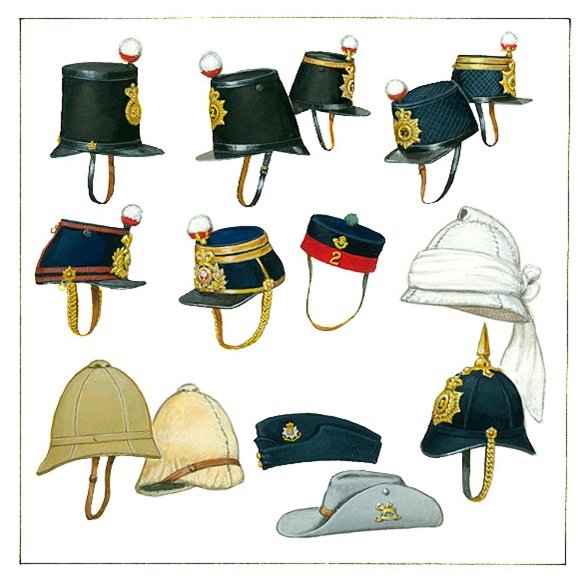- 17th and 18th Centuries
- 19th Century. First Half
- 19th Century. Second Half
- 20th Century
Headress History
19th Century. Second Half

19th Century. Second Half.
Top row: Shako 1846 (Albert), Shako 1855 other rank and officer, Shako 1861 (Quilted) other rank and officer. Second row: Shako 1868 other rank and officer, forage cap 1860, Linen covered cork or straw helmet 1857 (India). Bottom row: Foreign service helmet 1875 and 1890, Glengarry 1857, Field service cap (Austrian) 1895, Slouch hat 1900, Home service helmet 1879.
Top row: Shako 1846 (Albert), Shako 1855 other rank and officer, Shako 1861 (Quilted) other rank and officer. Second row: Shako 1868 other rank and officer, forage cap 1860, Linen covered cork or straw helmet 1857 (India). Bottom row: Foreign service helmet 1875 and 1890, Glengarry 1857, Field service cap (Austrian) 1895, Slouch hat 1900, Home service helmet 1879.
After the Crimea a second lighter shako, after the French style of the period, was introduced. It can still be seen today worn by the Band of the Royal Corps of Transport. Within five years a much lower shako similar to a kepi was introduced. This was made of cork and was covered in blue cloth. The cloth was stitched to the cork in a diamond pattern and was dubbed the ‘quilted’ shako. In 1868 yet another shako was introduced. This was possibly the most elegant of all, based on the previous style but tilted a little more to the front, with gold lace for officers and red braid for the men. This was the last shako.
The Home Service Helmet was introduced in 1879 and was similar in shape to the German ‘Pickelhaube’ of the period although higher in the crown and made of cloth covered cork. As with the German helmet it had a brass spike on the top. It can be seen today worn by regimental bandsmen in full dress. (Several examples can be seen at Clandon Museum).
Disastrous experiences in the Zulu and Boer Wars led to the abandonment of decorative uniforms in field conditions and to the development of khaki uniforms with appropriate headgear. The cloth covered Foreign Service Helmet, in use for some years in India and worn at the beginning of the Boer War was gradually superseded by the slouch hat turned up on one side. This is the hat familiar to WW2 forces serving in the Far East.
Various forms of undress cap had been worn since the Kilmarnock. Firstly the Glengarry which was followed by a blue Field Service Cap with folding neck cover and, in 1902, when the former scarlet undress frock was abolished, by the Brodrick cap. This was a blue cloth, peakless, round cap with a flat top with a regimental badge on the front. Khaki service dress, introduced in 1902, was thereafter worn on all occasions, except those where full dress was required. In these first years of the 20th century the blue Field Service Cap, the Brodrick and the Slouch hat could all be seen in wear. The Brodrick was unpopular and was replaced, in 1905, by a round, khaki, peaked cap which continued in use until the outbreak of WW2. At the same time a blue version of the peaked cap was introduced for wear in walking out when the full dress tunic was worn. During WW1 several versions of the khaki Service Cap appeared to accommodate the conditions of modern warfare. The steel helmet was introduced in 1916.
Copyright 2014 Linkorient.com. All Rights Reserved





 ++84 (0) 912.278.988
++84 (0) 912.278.988
